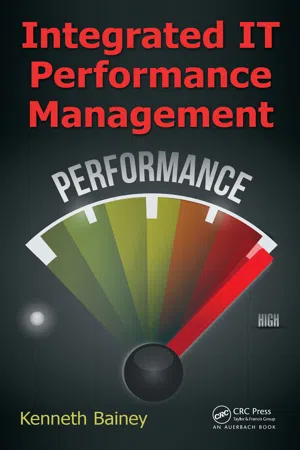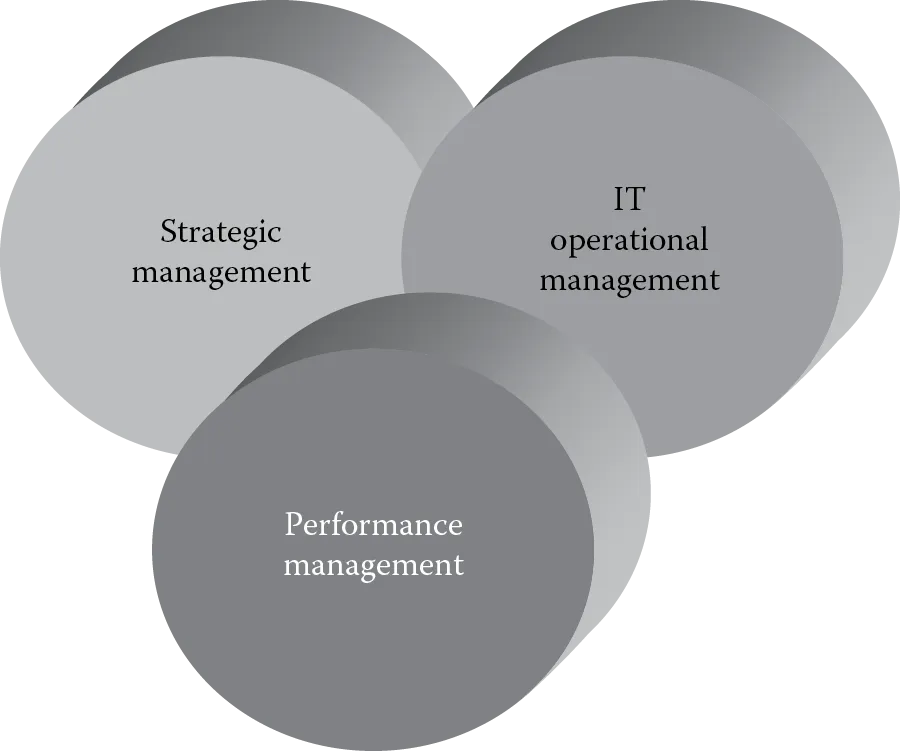
This is a test
- 428 pages
- English
- ePUB (mobile friendly)
- Available on iOS & Android
eBook - ePub
Integrated IT Performance Management
Book details
Book preview
Table of contents
Citations
About This Book
If you are in search of real-world practical scenarios of IT performance management practices, with a desire to obtain examples of strategic directives, accountabilities, outcomes, and performance measures for managing IT services, with an interest toward how performance management integrates with strategic and operational management, then Integrat
Frequently asked questions
At the moment all of our mobile-responsive ePub books are available to download via the app. Most of our PDFs are also available to download and we're working on making the final remaining ones downloadable now. Learn more here.
Both plans give you full access to the library and all of Perlego’s features. The only differences are the price and subscription period: With the annual plan you’ll save around 30% compared to 12 months on the monthly plan.
We are an online textbook subscription service, where you can get access to an entire online library for less than the price of a single book per month. With over 1 million books across 1000+ topics, we’ve got you covered! Learn more here.
Look out for the read-aloud symbol on your next book to see if you can listen to it. The read-aloud tool reads text aloud for you, highlighting the text as it is being read. You can pause it, speed it up and slow it down. Learn more here.
Yes, you can access Integrated IT Performance Management by Kenneth Bainey in PDF and/or ePUB format, as well as other popular books in Business & Operations. We have over one million books available in our catalogue for you to explore.
Information
Chapter 1
Introduction to Integrated IT Performance Management
1.1 Introduction
Not everything that counts can be counted, and not everything that can be counted counts.
William Bruce Cameran
Sociologist
Integrated Information Technology (IT) Performance Management as defined in this book is the process of integrating the components of strategic management, IT operational management, and performance management during the management, measurement, and delivery of IT services. The objective of this integrated process is to optimize the utilization of IT resources—people, process, financials, and technology, using a results-driven1 performance measurement and accountability framework. Figure 1.1 is a conceptual representation of the three major components of this framework that are discussed in further details throughout this book. The main focus is toward measuring outcomes and results rather than only measuring efforts, financials, and activities by counting inputs and outputs. This results-driven performance management and accountability framework is a set of practical strategic directives, accountabilities, outcomes, process flows, and performance measures, which demonstrate the integrated nature of strategic, IT operational, and performance management components. The unique difference of this framework is the model-centric2 approach, based on outcomes and results, rather than the traditional activity-oriented method. This model-centric approach to results-driven performance measures and accountability framework discussed in this book is a unique innovative solution that can be readily applied during the management, measurement, and delivery of IT services. It effectively addresses the root causes of performance management major challenges—integration, communications, transformational change, and accountability problems internal and external to organizational excellence.

Figure 1.1
Integrated IT performance management framework—conceptual view.
During my 35 years of experience in IT at various large companies in the private, public, and academic sectors, across Canada and United States, I have had the opportunity of working with senior and executive managers (IT and business) who, rightly so, stress the importance of the four famous performance management objectives:
- Effort allocations and utilizations (effort)
- Financial allocations and utilizations (financial)
- Work allocations and utilizations (activity)
- Performance measurement (KPI—Key Performance Indicators)
However, some of these senior and executive managers seem to measure performance based on these four famous performance management objectives, without any knowledge or consideration for strategic, operational, and performance management integration. In the majority of cases, these managers published performance metrics to demonstrate organizational successes, using the criteria of successfully meeting approved effort, financial, and activity objectives, with little regard for outcomes, results, and quality objectives. There was no consideration for integration, engagement, alignment, accountability, measurement, and improvement.
It is sometimes a common directive by senior and executive management who have limited exposure to the fundamental principles of integrated performance management to emphasize the human resource and personal systems aspects of performance management. They have little or no concern for what, why, or how outcomes or results are produced to support organizational excellence. Managers when confronted by executive management about the desire for consistent, integrated, and effective performance management practices across the organization, manage to recommend and convince executive management that the solution is a business process modeling or business reengineering initiative, using an activity-based performance management process. After closer assessments of this recommended solution, it is evident that some managers’ perception of performance management is based on activity-driven financial measures, rather than results-driven measures. The view of integration to optimizing the utilization of IT resources while improving on performance and enabling effective transformation change seems to be limited. There was no mention for strategic, operational, and performance management integration. In my view, we have just compounded the problems rather than solving the root causes of performance management major challenges—communications, integration, accountability, and change management problems internal and external to organizational excellence.
In a majority of such cases, another business process modeling or business reengineering initiative is justified with new activity-based performance measures. There are different key performance indicators for reducing or increasing human resource capacity, to sound impressive, and promote political attractiveness. The value of performance measures to generate efficiencies for organizational excellence through alignment to strategic and operational outcomes seem to be an ignored or unfamiliar concept. The end result of these performance measurement initiatives is to either reduce or increase human resources capacity to satisfy certain senior or executive managers’ ego, status, and political agenda, with the political logic to justify their decisions, using complex human resources policies. This is a typical case of illusions of efficiencies with nonproductive time, effort, and costs being applied to ineffective or wrong performance measures. The objective to optimize the utilization of people, process, financials, and technology resources for organizational excellence seems to be heading in a different direction.
The problems of the following continue to resurface, resulting in the elusive search for the magical “silver-bullet” solution:
- Accountability for Results
- Transparency
- Change Management
- Performance Improvement (Sustainability)
- Strategic Value integration
- Redundant and duplicated efforts
Executive management perception of the causes for lack of meaningful performance measures, blame the rigid activity-based method—too heavy emphasis on policies and processes and too little emphasis on people and finance. This new directive from executive management to focus on people and financial aspects without alignment to outcomes or results normally evolves into a chaotic organizational environment with unclear outcomes, meaningless measures, confusing targets, and inconsistent processes. Managers having no documented accountability, transparency, and performance measures—some managers’ favorite working environment. Lack of performance measurement systems encourages intuitive or emotional decision-making culture. The cycle in search for the “silver-bullet” performance solution continues, with presentations to executive management for more people and financial resources to support the existing complex policies and processes.
There is no “silver-bullet” solution. These performance management problems continue to resurface because of the lack of strategic, operational, and performance management integration framework. Structure measures org...
Table of contents
- Cover
- Half Title
- Title Page
- Copyright Page
- Dedication
- Table of Contents
- Preface
- Acknowledgments
- Author
- Chapter 1 - Introduction to Integrated IT Performance Management
- Chapter 2 - Integrated IT Performance Management Framework
- Chapter 3 - Strategic Management Model
- Chapter 4 - Performance Management Model
- Chapter 5 - Information Technology Operational Management Model
- Chapter 6 - Integrated IT Service Delivery Life Cycle Performance Model
- Chapter 7 - Aligning IPMF-IT Framework with Industry Best Practices
- Appendix A: Integrated IT Performance Measurement Dashboard—Executive Leadership Services (ELS)
- Appendix B: Integrated IT Performance Measurement Dashboard—Planning and Administration Services (PAS)
- Appendix C: Integrated IT Performance Measurement Dashboard—Enterprise Architecture Services (EAS)
- Appendix D: Integrated IT Performance Measurement Dashboard—Project Portfolio Management (PPM)
- Appendix E: Integrated IT Performance Measurement Dashboard—Applications Management Services (AMS)
- Appendix F: Integrated IT Performance Measurement Dashboard—Technology Operations Services (TOS)
- Index